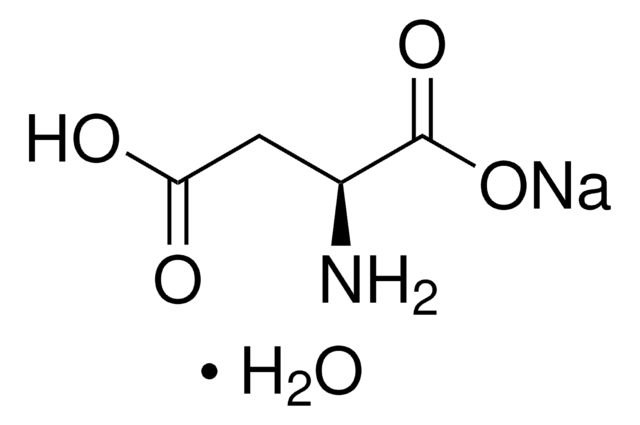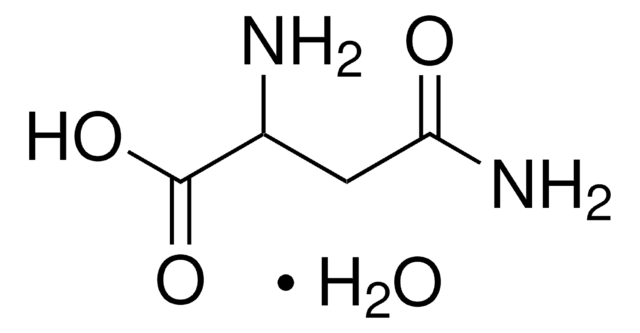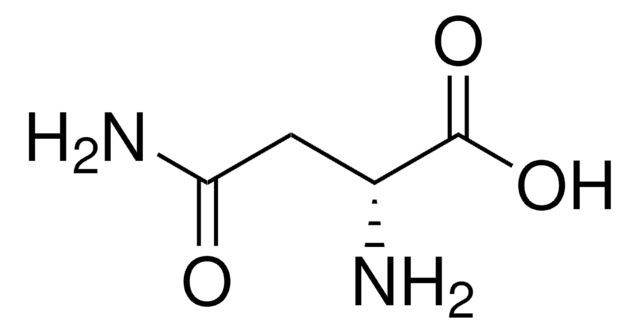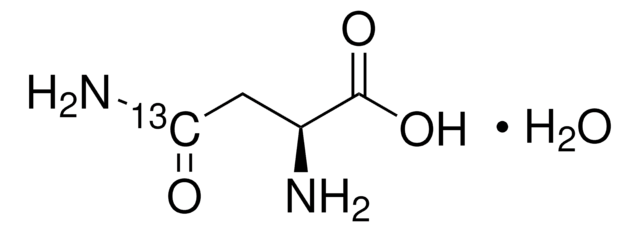Wichtige Dokumente
A8381
L-Asparagin Monohydrat
≥99% (TLC)
Synonym(e):
(S)-(+)-2-Aminobernsteinsäure-monoamid, (S)-2-Aminobernsteinsäure-4-amid, L-Asparaginsäure-4-amid
About This Item
Empfohlene Produkte
product name
L-Asparagin Monohydrat, ≥99% (TLC)
Biologische Quelle
synthetic
Qualitätsniveau
Assay
≥99% (TLC)
Form
powder
Farbe
white to off-white
mp (Schmelzpunkt)
233-235 °C (lit.)
Anwendung(en)
cell analysis
peptide synthesis
SMILES String
[H]O[H].N[C@@H](CC(N)=O)C(O)=O
InChI
1S/C4H8N2O3.H2O/c5-2(4(8)9)1-3(6)7;/h2H,1,5H2,(H2,6,7)(H,8,9);1H2/t2-;/m0./s1
InChIKey
RBMGJIZCEWRQES-DKWTVANSSA-N
Suchen Sie nach ähnlichen Produkten? Aufrufen Leitfaden zum Produktvergleich
Allgemeine Beschreibung
Anwendung
- as a component of Sauton′s and chelated Sauton′s media for mycobacterial growth
- to test its effect in the induction of Ca2+ flux in rice roots using aequorin luminescence imaging
- as a component of fermentation medium for the Blakeslea trispora spores
Biochem./physiol. Wirkung
Lagerklassenschlüssel
11 - Combustible Solids
WGK
WGK 1
Flammpunkt (°F)
Not applicable
Flammpunkt (°C)
Not applicable
Persönliche Schutzausrüstung
Eyeshields, Gloves, type N95 (US)
Analysenzertifikate (COA)
Suchen Sie nach Analysenzertifikate (COA), indem Sie die Lot-/Chargennummer des Produkts eingeben. Lot- und Chargennummern sind auf dem Produktetikett hinter den Wörtern ‘Lot’ oder ‘Batch’ (Lot oder Charge) zu finden.
Besitzen Sie dieses Produkt bereits?
In der Dokumentenbibliothek finden Sie die Dokumentation zu den Produkten, die Sie kürzlich erworben haben.
Kunden haben sich ebenfalls angesehen
Unser Team von Wissenschaftlern verfügt über Erfahrung in allen Forschungsbereichen einschließlich Life Science, Materialwissenschaften, chemischer Synthese, Chromatographie, Analytik und vielen mehr..
Setzen Sie sich mit dem technischen Dienst in Verbindung.









